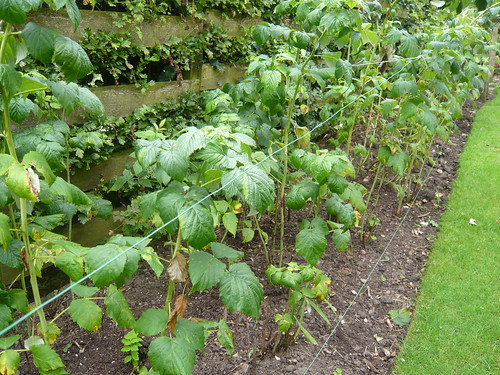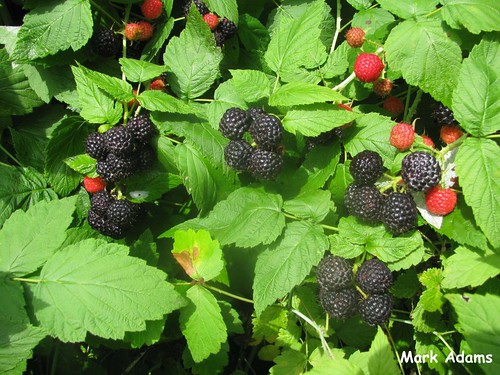Coloured and Species Raspberries
Red Raspberries
A 20-foot row of raspberries (Rubus idaeus) will yield a good crop over several weeks. Enough for jam, puddings and eating fresh.
A traditional hedge-type planting will yield twice the fruit of single trained canes but takes at least twice the space.
Intensively trained berries are extremely productive on single stems against a wall or fence.
To get the most from red raspberries, plant at least two kinds, an early or main crop variety for heavy early summer harvests, and an autumn or continually-bearing type.
It’s a mistake to cut raspberry canes back in an effort to make the canes self-supporting. You get the best results by tying the canes to two wires at 2-1/2 and 5 feet off the ground. The most fruitful buds are those nearest the top of the canes.
Autumn raspberries fruit on new canes at the end of their first growing season and again the following summer. For heavier crops, prune the canes to the ground after the first harvest in autumn and forego the summer crop. Raspberry ‘Autumn Bliss’ is one of the best and most reliable primocane or autumn fruiting varieties. They produce a heavy crop of large, attractive red berries from late August until mid October.
Black Raspberries
Rubus occidentalis commonly known as “blackcaps” are occasionally cultivated providing both fresh and frozen fruit with a distinctive, richer flavour and high fiber content.
Although closely related to the reds, black raspberries have a distinctive flavor, ripen a little later, and require slightly different training.
Black raspberries spread by bending the tips of their canes to the ground where they root. In an attempt to bend to the ground and root, the canes elongate and become thin and weak at the tips. Unless you want to start new plants, cut these canes back to 3 or 4 feet.
Cut the old canes out after harvest. Since black raspberries don’t throw root suckers, they take much less thinning than reds.
Purple raspberries have been produced by horticultural hybridization of red and black raspberries.
Yellow Raspberries
Raspberry ‘Allgold’ Rubus idaeus is an autumn fruiting yellow raspberry.
There is an orange raspberry also called golden raspberry. It is quite delicious and grows just like regular raspberries – ie on canes held high.
pale-yellow natural or horticultural variants of both the red and the black raspberry species have albino-like fruit resulting from recessive genes that impede production of anthocyanin pigments.
Raspberry Species
credit Wikipedia
Rubus crataegifolius (Korean raspberry)
Rubus gunnianus (Tasmanian alpine raspberry)
Rubus idaeus (European red raspberry)
Rubus leucodermis (Whitebark or Western raspberry, Blue raspberry, Black raspberry)
Rubus occidentalis (Black raspberry)
Rubus parvifolius (Australian native raspberry)
Rubus phoenicolasius (Wine raspberry or Wineberry)
Rubus rosifolius (West Indian raspberry)
Rubus strigosus (American red raspberry) (syn. R. idaeus var. strigosus)
Rubus ellipticus (Yellow Himalayan Raspberry)
You can buy several red raspberry varieties mail order from Thompson & Morgan
Several species of Rubus are also called raspberries that are classified in other subgenera, including:
Rubus arcticus (Arctic raspberry, subgenus Cyclactis)
Rubus deliciosus (Boulder raspberry, subgenus Anoplobatus)
Rubus nivalis (Snow raspberry, subgenus Chamaebatus)
Rubus odoratus (Flowering raspberry, subgenus Anoplobatus)
Rubus sieboldii (Molucca raspberry, subgenus Malachobatus)
Credits
Wild Black Raspberries, SW MO by MarkInspex CC BY-ND 2.0
Raspberries by MonkeyBoy69 CC BY-NC-SA 2.0



2 thoughts on “Coloured and Species Raspberries”
Comments are closed.